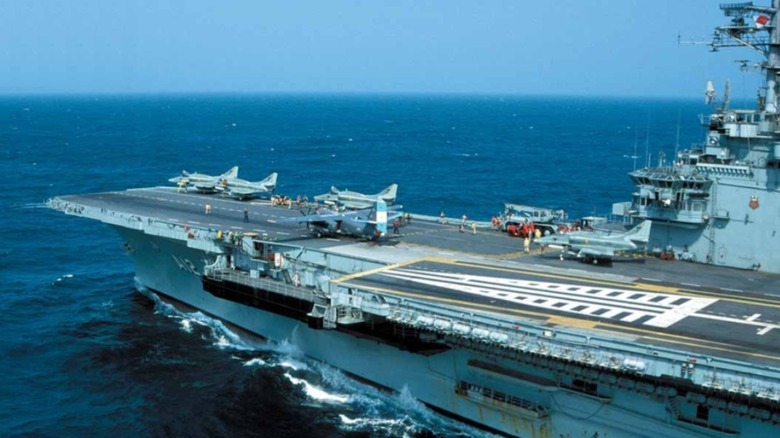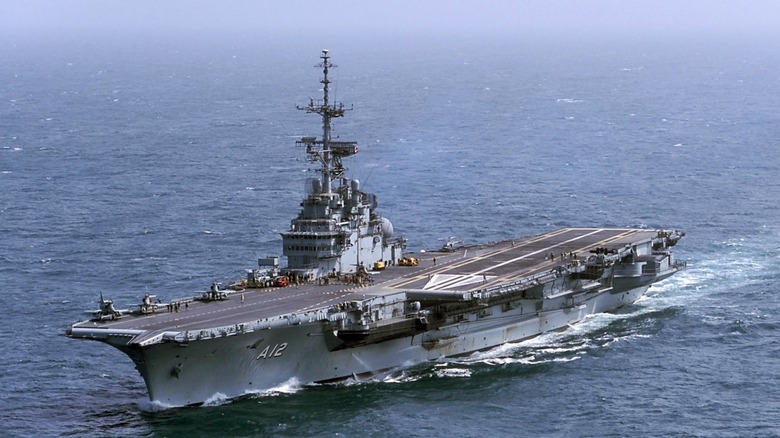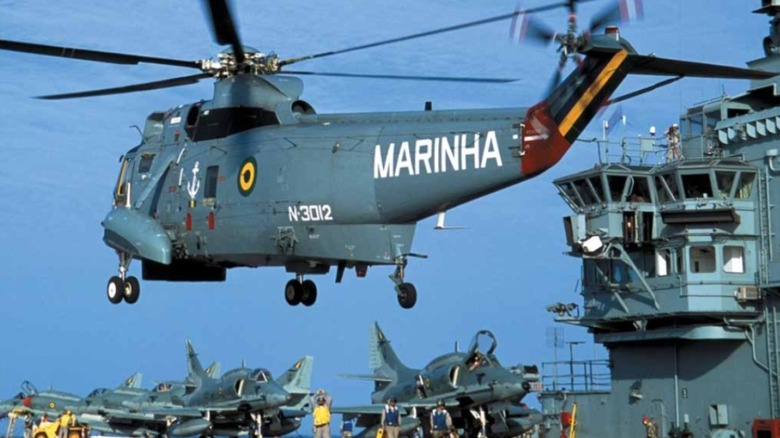Why Brazil Sank Its Own Aircraft Carrier In 2023
Aircraft carriers are formidable vessels in terms of raw size, defense, and entourage. American aircraft carriers are notoriously hard to sink, but on some occasions, the militaries of the world scupper theirs. A ruined vessel, for instance, mayuseless unless sold for scrap, or to serve the nation one last time in a live-fire exercise. Alternatively, a controlled sinking may be a better option than simply allowing a vessel rot. This was exactly the case in 2023, when Brazil sank its own aircraft carrier, the Sao Paulo.
This vessel has had a long and troubled history, originally being built to serve the French navy's Clemenceau class of aircraft carriers. The French were making room for a new carrier, the Charles De Gaulle, and so the Foch, as the French originally named the vessel, was decommissioned. When the Brazilian navy acquired it in 2000, it renamed it after the city. But its transfer to Brazil was fraught from the start. In the mid-2000s, the ship was rocked by an engine room accident that caused an explosion, with even worse damage to come when a fire broke out in 2012.
Though the Brazilian navy made it to serve as its flagship, its time was marked by poor technical performance and unreliability, which meant that regular maintenance work was needed, harming readiness. When it was sunk, it caused even more controversy for what it was carrying, and for the Brazilian government's decision not to take a more eco-friendly tack.
The Sao Paulo's troubled history
The purchase of the Sao Paulo, Reuters note at the time of its sinking, cost Brazil approximately $12 million. Bringing it up to the required standard, however, was an expensive business too. The outlet reported that the vessel required a major overhaul to the tune of about $80 million, but that this wasn't ultimately done. Nonetheless, the vessel proved to be a huge and impractical money-sink. In the wake of the blast in 2004, the vessel required extensive repairs that cost approximately $18 million, necessitated by damage to important systems such as the Naval Tactical Data System and the catapults.
The sheer size of an aircraft carrier can make even routine maintenance work time-consuming and expensive, so issues on this scale were devastating. After the 2005 blast, it required additional attention, but 2012 marked the outbreak of another fire on the Sao Paulo. This blaze would require a whole new round of renovations, repairs, and refits, ultimately leading the Brazilian navy to the conclusion that the carrier simply couldn't be maintained.
In 2017, Brazil's naval priorities revolved around different vessels (primarily corvettes), and to keep the Sao Paulo in a condition for Brazilian fighter jets at the time to use it to land on would have required significant investment in the carrier. It wasn't reliable enough for its purpose, in short, and at the time, its purpose wasn't important enough to the Brazilian navy even if it had been. In an attempt to cut its losses, September 2019 marked the start of Brazil's attempt to try and sell it. Even a bargain $1.275 million starting price didn't entice anybody.
Hazardous materials were aboard the Sao Paulo when it was sunk
These vessels, such as the U.S. Navy's enormous USS Gerald R. Ford or the British HMS Queen Elizabeth, carry a tremendous amount of national pride. Unfortunately, when the Sao Paulo was scuttled in 2023, it was also carrying something else: A significant quantity of dangerous material. The Brazilian government was not permitted to take the Sao Paulo to it's desired resting spot. It was sold for scrap to Turkey but couldn't be delivered over concern that asbestos had been used in its construction. Greenpeace Brazil's Leandro Ramos, The Guardian reported at the time, noted, "environmentally responsible measures could have been adopted, but once again, the importance of protecting the oceans, which are vital for the life of the planet, was treated with negligence."
According to the outlet, the vessel's poor condition and the materials aboard it forced the decision in the eyes of Brazilian officials. There was no port willing to accept it for potential safer disposal. As such, with the danger that the carrier could deteriorate and freely discharge the materials, it was instead decided that the vessel would be scuttled. This was the claim reportedly made by a Brazilian Navy statement, which argued, via Naval News, "The location for the hull's final disposal, Guas Jurisdicionais Brasileiras (AJB), 350 kilometers from the coast and with a depth of approximately 5,000 meters, was chosen based on research conducted by the Navy Hydrography Center and the Institute of Studies of the Sea Almirante Paulo Moreira," with the idea of minimizing harmful impact.


